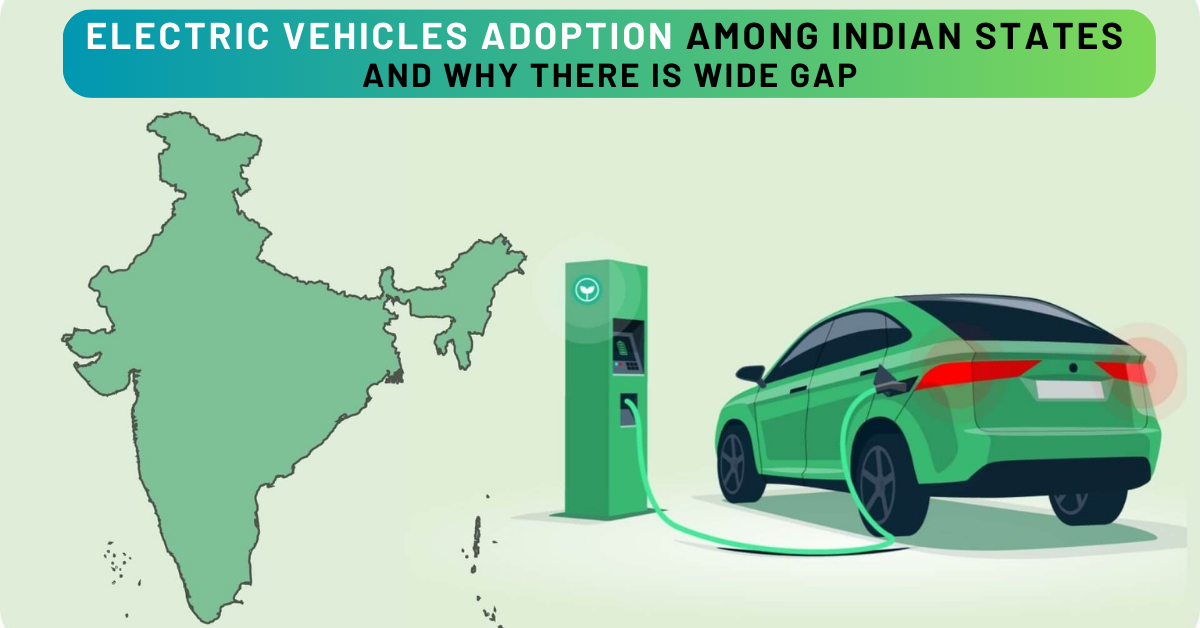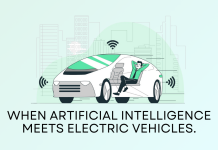The growing pollution in India and its agreement to the Paris Agreement (which aims to limit global warming to 1.5°C by the end of this century) has made the country set a target for clean energy. India has committed to achieve a net zero emissions economy by 2070. The Indian government has also set a target to achieve 30 percent electrification of the country’s vehicle fleet by 2030. Presently, India is the third largest automobile market globally in terms of sales, ahead of Germany. Several schemes like FAME-2 (Rs 5,172 crore for FY 2023-24) and other Production Linked Incentive Scheme (PLI) have been launched by the Central Government to foster electric vehicles (EVs) industry in the country. India has 6.41% EV adoption rate this year as compared to 4.75% in 2022. The total unit of EVs sales in 2023 (till Oct 27), 2022, and 2021 are 12,03,941, 10,24,804, and 3,31,482 respectively.
On the national level, the number of EVs per 10,000 of the population is 9.08 for the year 2023. But this ratio varies widely among the states, Goa has the highest ratio which is 48.46 while Nagaland has the lowest ratio which is 0.0194. The number wise top three states for EVs sales in 2023 are Uttar Pradesh (2,14,897), Maharashtra (1,51,539), and Karnataka (1,21,156). The below indicates the ratio of electric vehicles per 10,000 of population among Indian States/UTs for the year 2023:
EV Adoption Ration State Wise In Indian States
| S.No | State/ UT | EVs Sold# | Population* | Ratio |
| 1 | Nagaland | 4 | 2,073,074 | 0.019 |
| 2 | Arunachal Pradesh | 14 | 1,711,947 | 0.081 |
| 3 | Meghalaya | 97 | 3,772,103 | 0.25 |
| 4 | Andaman & Nicobar Island | 13 | 399,001 | 0.325 |
| 5 | Mizoram | 102 | 1,308,967 | 0.779 |
| 6 | Ladakh | 28 | 297000 | 0.94 |
| 7 | Manipur | 367 | 3,436,948 | 1.06 |
| 8 | Himachal Pradesh | 914 | 7,503,010 | 1.21 |
| 9 | UT of DNH and DD(3) | 112 | 773,997 | 1.44 |
| 10 | West Bengal | 15,350 | 100,896,618 | 1.52 |
| 11 | Andhra Pradesh | 26,739 | 91,702,478 | 2.91 |
| 12 | Jharkhand | 16,282 | 40,100,376 | 4.96 |
| 13 | Jammu Kashmir | 7,441 | 14,999,397 | 4.96 |
| 14 | Bihar | 68,280 | 128,500,364 | 5.31 |
| 15 | Madhya Pradesh | 51,646 | 85,002,417 | 6.07 |
| 16 | Punjab | 19,876 | 30,501,026 | 6.51 |
| 17 | Orissa | 33,375 | 47,099,270 | 7.08 |
| 18 | Haryana | 24,289 | 28,900,667 | 8.4 |
| 19 | Tamil Nadu | 74,327 | 83,697,770 | 8.88 |
| 20 | Chhattisgarh | 28,851 | 32,199,722 | 8.96 |
| India | 12,04,484 | 1,326,093,247 | 9.08 | |
| 21 | Rajasthan | 72,391 | 79,502,477 | 9.1 |
| 22 | Uttar Pradesh | 2,14,897 | 231,502,578 | 9.28 |
| 23 | Gujarat | 75,783 | 70,400,153 | 10.76 |
| 24 | Uttrakhand | 13,215 | 11,700,099 | 11.2 |
| 25 | Tripura | 4,937 | 4,184,959 | 11.88 |
| 26 | Maharashtra | 1,51,539 | 124,904,071 | 12.13 |
| 27 | Pondicherry | 2,140 | 1,646,050 | 13 |
| 28 | Assam | 50,494 | 35,998,752 | 14 |
| 29 | Karnataka | 1,21,156 | 69,599,762 | 17.40 |
| 30 | Kerala | 61,498 | 34,698,876 | 17.72 |
| 31 | Delhi | 55,654 | 19,301,096 | 28.83 |
| 32 | Chandigarh | 4,932 | 1,158,040 | 42.58 |
| 33 | Goa | 7,377 | 1,521,992 | 48.46 |
# EVs sold till 27 Oct 2023, and includes all categories (2W/3W/4W)of vehicles. *2023 Estimated population (https://www.indiacensus.net/)
Almost the same pattern of EVs adoption ratio among the states is followed in 2022, and 2021. And the reasons may be
- Topography: The states which have ratios below the national ratio are rich in biodiversity and urban pollution is not the major concern of these states. These states have large hilly and forest areas. So, the people are not facing the pollution issues as compared to metropolitan cities like Delhi, Mumbai and are not potentially willing for electric vehicles.
- Lack of EV-based Infrastructure: OEMs are not focusing on setting up their presence in these states and mainly focusing on metro cities where they get huge customers to expand their business. This makes unavailability of showrooms, charging stations, and service centers for these states.
- Technology Limitations: Presently EVs are in the developing phase due to their battery and motor propulsion capacities. Driving EVs for hilly and floody reasons is still a major challenge as compared to petro/diesel based vehicles. Many EVs are not able to drive due to the sharp inclination of hills and ultimately are not attracted by the customers.
- Policies: These states are lacking in active government policies for adoption of EVs. OEMs are not attracted by the government to set up their manufacturing units and other activities in these states although subsidy is provided by almost all the states but that is not at all enough to boost EV adoption. There is no compulsion for IC engines registration in these states like Chandigarh where conventional vehicles are restricted for registration.
Read More: E-Mobility – Adoption Strategy, Challenges, and Route-Ahead







